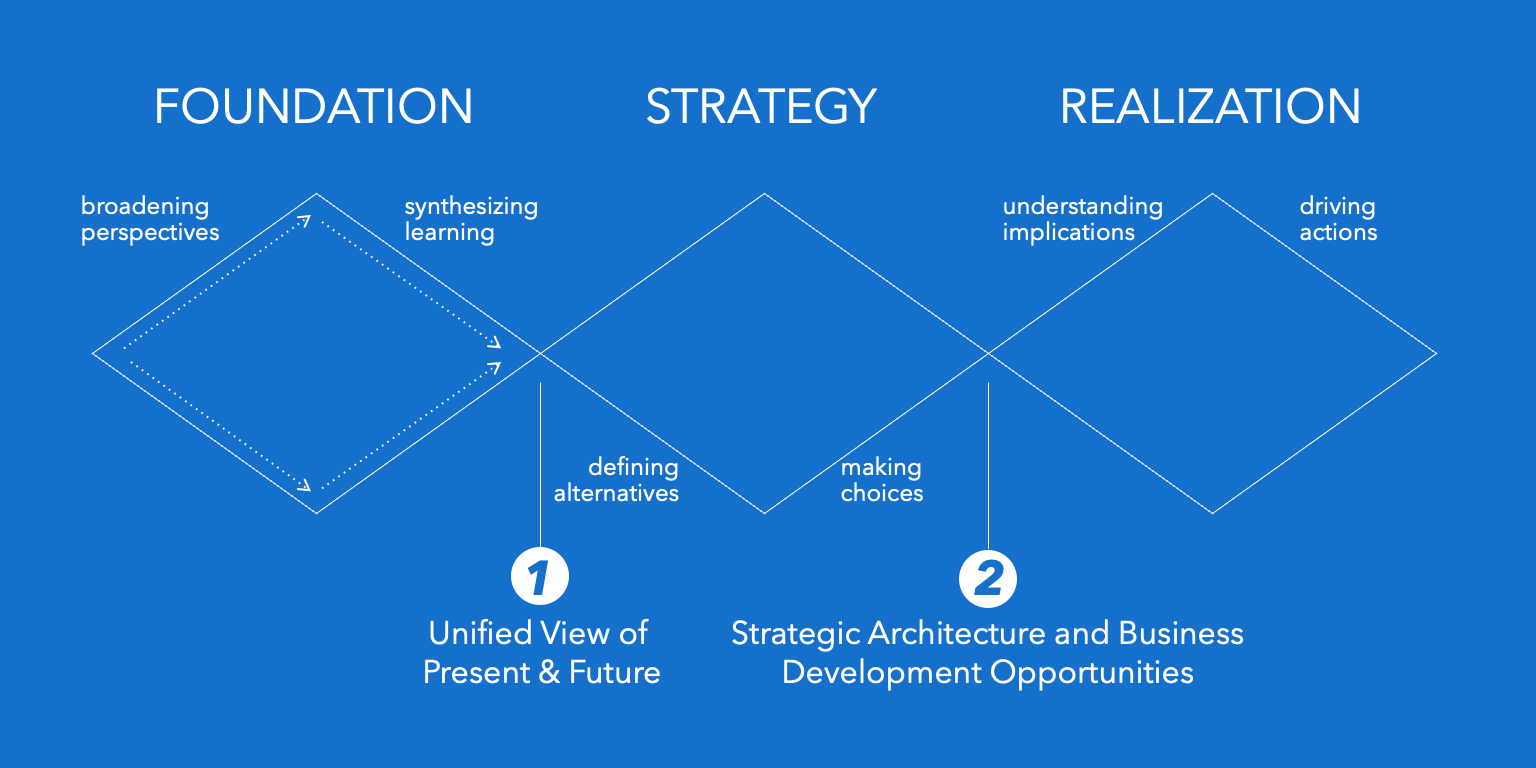The Power of Inclusivity in Strategy Creation
In an ever-changing business environment, the organizations that innovate and thrive recognize the power of inclusivity and diversity. The need to harness this power during strategy creation has never been more critical. But what does that mean, and how does it work?
In this article
The Imperative for Inclusive Strategy.
Much has changed in the last three years, but much has returned to how things were before COVID-19. The one change that endured is that today, we are a hybrid, mobile, distributed workforce. While this has its advantages, it also means culture develops differently, and cohesion is at risk.
What hasn’t changed is that strategy creation still seems to be the domain of the C-suite. Leadership is at risk of being even further removed from the periphery, where the eyes and ears of the organization reside and customer interaction occurs. How do we incorporate inclusivity and diversity into a core business process such as strategy development?
Since 1995, we have collaborated with over 400 clients whose senior executives realized that most of what could be known about their business resides outside the closed doors to the boardroom. These progressive leaders sought a different approach to strategy development and approached Strategos for support.
Before diving into the particulars, there are four main reasons why inclusive strategy creation is imperative to a business.
- Enhanced Innovation: Diverse teams bring many perspectives, experiences, and problem-solving approaches. This diversity is the breeding ground for and enhances breakthrough ideas and innovative solutions. A homogenous group might miss out on these unique insights.
- Fueling Growth: An inclusive strategy allows organizations to develop a broader range of options. By understanding and addressing the needs of diverse customer segments, identifying discontinuities early, challenging competitive rules, and leveraging core competencies, businesses can tap into new markets and revenue streams to grow in adjacencies and transformational spaces.
- Risk Management: A diverse team is more likely to identify potential risks from various angles and identify critical assumptions about the strategic options it is considering. The trick is to learn about new opportunities faster than to commit resources; learn before you earn.
- Talent Attraction & Retention: In the war for talent, inclusivity and diversity are not just nice-to-haves but assets to leverage. Today’s top talent values inclusivity, which includes being heard and even participating in developing innovative strategies. A compelling strategy needs to resonate not just with customers but with employees as well if we expect them to rally behind it.
Understanding its Principles.
Inclusivity goes beyond mere representation. It’s not just about having diverse team members but ensuring their voices are heard, respected, and integrated into decision-making processes. Three additional requirements are essential to make this approach stick and produce results:
- Beyond Representation: While having a diverse workforce is essential, it’s the engagement, empowerment, and value derived from this diversity that makes the difference. For greater diversity, team members are chosen based on a different set of criteria than seniority or politics. In all our client projects, we seek diversity along various dimensions such as experience, industry, level, function, gender, character, etc. Having different people working together is how to successfully embed inclusivity in your organization. Working in teams on strategy development creates mutual understanding and respect for diverse viewpoints from people with diverse backgrounds.
- Cultural Competence: The ability to understand, communicate, and effectively interact with people across different cultures, especially for global businesses. In a globalized world, cultural competence is a must-have skill for organizations. And especially when workforces are distributed and often remote, the challenge of effective communication becomes even more significant. This competence allows us to adapt processes and tools to match cultural backgrounds and ensure maximum participation.
- Leadership Commitment: Leaders set the tone. Leaders can inspire the organization to follow suit by promoting and valuing inclusivity. Trust is the foundation of any successful strategy. By showing commitment and communicating openly about the goals, progress, and outcomes of the strategy, organizations can build and maintain this trust.
- Stakeholder Engagement: Actively seek input from a diverse range of stakeholders. This enriches the strategy and fosters a sense of stakeholder ownership and commitment. The world is dynamic, and so are stakeholder needs. Organizations must be agile, continuously learning and adapting strategies to stay relevant.
A Different Approach to Strategy Creation.
Our Strategic Architecture Process is an inclusive and open approach that helps decision-makers create compelling, differentiated strategies by following fundamental principles
- Open up the process: It is essential to understand that strategy creation should be a pluralistic, participative, and inclusive process involving employees from diverse backgrounds within your organization using a range of selection criteria instead of limiting it to seniority. This ensures a wide range of perspectives and ideas, fostering innovation and creativity and encouraging new conversations that break the cycle of the same people discussing the same issues. This can lead to new perspectives and insights and a more robust strategy that resonates across and beyond the organization.
- Raise the ambition: The goal should be competitive innovation instead of competitive imitation. Instead of simply playing the same game better, aim to fundamentally change the game in ways that differentiate and create value that matters to customers. Applying approaches used for innovation to strategy-making will achieve this much better than traditional competitive and market analysis.
- Create balance: Your strategy should require you to make tough choices and be clear about what initiatives to stop, what to start, and what to keep. Re-allocate investments where they impact the most and re-align your portfolio to create a focus for marketing and sales teams in the short term while you explore new areas of opportunity to fill the gaps.
- Use a structured approach: The Strategic Architecture Process is highly structured to ensure progress and facilitate broader participation. Traditional strategy development extrapolates from the past to the present into the future and matches ambitions with available resources. Instead of this method of strategic fit, our future-back approach starts with defining a united view of the future that introduces stretch and challenges the organization to find innovative ways to meet its goals. We achieve this stretch by diverging and converging in each major step.

Let’s talk! We’re always interested in hearing from you about the plans you have and exploring opportunities to collaborate.
Overcoming Challenges.
While the benefits of an inclusive strategy creation process are evident, implementing it is challenging. In our experience, leaders can face resistance, skepticism, and concerns about confidentiality.
Our Strategic Architecture Process is designed to avoid the common pitfalls of strategy development. Ambitious goals are essential, but imposing an unrealistically short time frame invites disaster. The gap between formulation and implementation often results in theoretical exercise that doesn’t lead to ownership and action. Organizational hierarchy undermines competitiveness by fostering an elitist view of management that tends to disenfranchise most of the organization. Employees should identify with the strategy and feel a part of its creation and execution.
The Future of Inclusive Strategy.
Inclusivity should be core to strategy development. For senior leaders, now is the time to embrace and champion an inclusive approach to strategy. The benefits are manifold, from enhanced innovation and market expansion to robust risk management and talent attraction.
Ready to Dive Deeper?
Creating a compelling, differentiating strategy is a complex task that requires a deep understanding of your organization, your competitors, and the market. It involves creativity, innovation, and the ability to engage your entire organization. At Strategos, we specialize in helping organizations navigate this process. We bring an inclusive approach and collaborate with you to create a strategy that differentiates your organization to drive growth. Contact us today to learn more about how we can help.
Further Reading & Resources.
For those keen on deepening their understanding, we recommend the following resources:
- Strategic Intent, Gary Hamel
- Innovation to the Core, Strategos
- Develop a Winning Growth Strategy (video), Strategos

Strategy Re-calibration: When, Why, and How to Redefine Your Path to Growth
Is your Strategy delivering the results you expected? Do you feel you’re falling short of the ambitions…
Read more
How ZF improved their Innovation System.
Gandert van Raemdonck, Head of Innovation at ZF Commercial Vehicles, discusses how innovation drives the future of…
Read more
How to Navigate Business Disruption
No company can think it is immune from the threat of disruption. The term disruption is overused,…
Read more